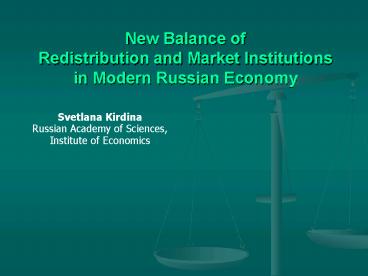New Balance of Redistribution and Market Institutions in Modern Russian Economy - PowerPoint PPT Presentation
1 / 19
Title:
New Balance of Redistribution and Market Institutions in Modern Russian Economy
Description:
Economy, politics and ideology in the society are strongly interrelated ... communitarian ideology. unitary-centralized political order ... – PowerPoint PPT presentation
Number of Views:51
Avg rating:3.0/5.0
Title: New Balance of Redistribution and Market Institutions in Modern Russian Economy
1
New Balance of Redistribution and Market
Institutions in Modern Russian Economy
- Svetlana Kirdina
- Russian Academy of Sciences,
- Institute of Economics
2
Main parts of presentation
- Methodology
- Results
- Explanations
3
Institutional matrices theory
- Economy, politics and ideology in the society are
strongly interrelated - Economic, political and ideological institutions
comprise - the institutional matrix of the society
- Two types of institutional matrices can be
singled out an X-matrix and an Y-matrix - (in details see Kirdina S. in Proceedings of
Hawaii International Conference on Social
Sciences, 2003 or www.kirdina.ru)
4
X- and Y-matrices
redistribution economy
X
Y
federative-subsidiary political order
ideology of subsidiarity
unitary-centralized political order
communitarian ideology
market economy
5
Combinations of X- and Y-matrices
- Russia, China, the USA and
- most Asian and European
- Latin America countries countries
6
X- and Y-institutions in economy and their
functions
7
Causes of economic reforms
- By the middle 1980s on the eve of perestroika (in
terminology of the Soviet Union) or transition
economy (in terms of world social sciences)
Russia had the unbalanced institutional economic
structure. - Only redistribution X-institutions predominated.
Necessary market Y-institutions were undeveloped
and performed as latent, shadow or illegal forms.
- Such disbalance resulted in the non-efficiency of
the social system and the deep decrease of its
economic and social parameters.
8
The first phase of institutional reforms-1
- In the middle of 1980s new political leadership
began to develop the market Y-institutions on the
legislative basis - the privatization of the majority of the state
enterprises put into practice to create the
private property - the decentralization in the economic governance
system was realized to develop the exchange
transactions instead of redistribution. The state
planning system (Gosplan) was eliminated. The
price management was stopped
9
The first phase of institutional reforms-2
- new laws about the creation and liquidation of
business in all branches of economy were passed
to promote the competition - the contract labor institution substitutes for
the employed labor because the state system of
manpower training and distribution was
liquidated. The relationships between employees
and employers became the subject of the contract.
The state salary management was canceled - gaining profit (Y-efficiency) becomes the main
criteria for new enterprises and their owners
acting in open and competitive market
environment.
10
The result of first phase of reforms
- The attempt to replace the redistribution
institutions by the market ones was not very
successful - It was neither growth of the total efficiency in
economy nor expected efficiency increase of the
new companies - In 1998 after the default the state economic
policy was turned to the search for the optimal
and balanced combination of related market and
redistribution economic institutions.
11
The second phase of institutional reforms - 1
- Since late 1990s early 2000s new political
leaders paid more attention to the modernization
of redistribution X-institutions rather than to
the implementation of market Y-institution as it
was before - the supreme conditional property - the creation
of the large-scale joint-stock companies and
holding structures under the management (or with
control share in capital) of federal or regional
governments - the redistribution - new National Projects and
State Corporations under the federal governance
and supported by the federal budget. The
centralized structure of them on the new level
puts the redistribution scheme into life
12
The second phase of institutional reforms - 2
- the cooperation - state bodies involve different
business structures into the decision-making
process of the development of the country
(investment participation including) and
encourage the establishment of different forms of
cooperation with business structures - the employed labor institution - the
organization of the industry specialists
education system on the basis of
private-and-state partnership with the state in
leading position and the growth of non-monetary
social factors of labor reward - cost reduction (X-efficiency) - price and tariffs
regulation both on federal and regional levels.
The main objective of the corresponding
commissions is not the revenue of the companies
but the decrease of general resources use as well
as national product expenditure.
13
Picture of the institutional dynamics
t
2007
1998 (default)
Y Market institutions
X Redistribution institutions
1985
0
1
14
Actual result of Russian reforms
- The new balance of redistribution and market
institutions is being created in Russia in favor
of the former. - It goes along with the recent growth of economic
and social development indexes in Russia. In 2006
Russia occupied the 10-th(compare to the 18-th in
2005) place on the GDP index in the world.
15
Why the redistribution model dominates?
- The prevailing of redistribution institutions in
Russian economy is not the result of the
malicious intent of some political forces or the
consequence of traditional and undeveloped
Russian society. - Marshall marginal approach explains the
objective and pragmatic reasons for the
redistribution model dominating.
16
Equilibrium of supply and demand for branches
with increasing marginal returns
17
Equilibrium of supply and demand for branches
with diminishing marginal returns
18
The conclusion
- In Russia the share of branches with diminishing
marginal returns such as transportation,
energetic complex, housing and social spheres
is more than a half (57 per
cent of fixed assets in 2006). - According to the marginal costs theory here the
redistribution institutional structure is more
preferable than the market one. - New balance of redistribution and market
institutions in modern Russian economy confirms
it.
19
- Thank you for your attention.
- www.kirdina.ru
- kirdina_at_inecon.ru































